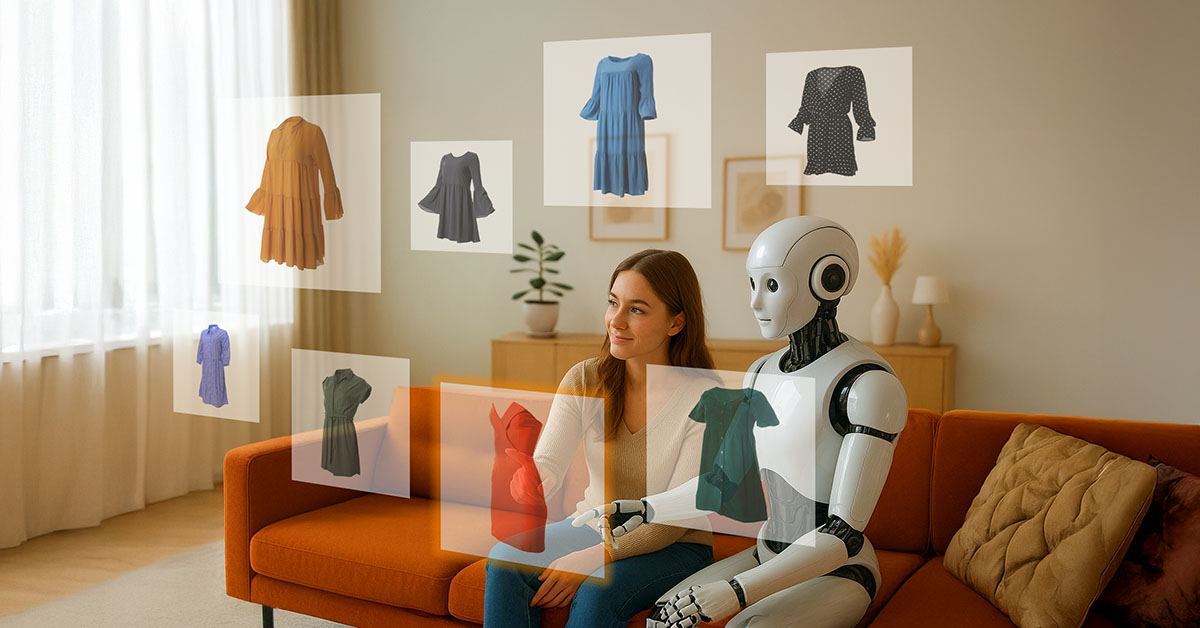
Agentic Commerce: Where Conversations Become Transactions
We are witnessing another power shift in digital commerce. The next checkout won’t be a webpage — it will be the chat window where you ask for advice.
A new e-commerce model is emerging — often called Agentic Commerce — where purchases happen directly inside conversations with AI assistants. Some describe it as the next evolution of conversational commerce (Conversational Commerce 2.0) but this time, the agent doesn’t just recommend products. It buys them for you.
How It Works: From Conversation to Checkout
The mechanism behind agent-led shopping generally follows a clear sequence:
Step 1. Intent capture
The process begins when the user formulates a request — for instance, asking for a “minimalist desk lamp under 80 €.” The AI interprets the query, analyzes preferences and constraints, and retrieves relevant product data from integrated merchant feeds.
Step 2. Intelligent product selection
Using structured metadata such as price, material, color, availability, and customer reviews, the AI agent compiles a shortlist of matching products. Recommendations are typically ranked by contextual relevance and user fit, not by sponsored placement.

Step 3. In-chat checkout
Once the user chooses a product, the assistant enables checkout directly in the conversation window. Payment, shipping, and confirmation happen within the same interface — no external redirects, no multiple tabs. This step removes the friction of switching platforms and shortens the buying journey to a single interface.
Step 4. Secure payment authorization
Instead of exposing sensitive payment credentials, the AI agent relies on a tokenized or delegated authorization system provided by the payment processor.
Whether through Stripe’s ACP, Google’s AP2, or similar emerging standards, the core principle remains the same: transactions are verified without the AI ever storing card data. These protocols — and their growing role in building the agentic commerce infrastructure — are explored later in this article.
Step 5. Merchant-side fulfillment
The order and payment confirmation are transmitted via standardized APIs to the merchant’s back-end systems. The merchant validates the transaction, handles taxation, fulfillment, and customer communication, while the AI acts as an intermediary between user and seller.
Step 6. Continuous optimization
Each interaction generates insight into user intent, conversion behavior, and product relevance. Over time, this feedback loop enables both merchants and AI providers to refine recommendations and improve the efficiency of agent-driven transactions.
Reality Check: Agentic Commerce Goes Live
Agentic Commerce is no longer a thought experiment or a slide in a keynote deck.
Over the past months, several leading technology firms have begun rolling out real, functioning implementations of AI-led shopping — systems that turn conversation into transaction. What was once a speculative idea is now appearing in production: users can browse, buy, and pay directly inside chat interfaces.
The following examples show how quickly this new model is moving from theory to market reality — and how differently each player is trying to capture its share of the coming AI commerce layer.
OpenAI and Stripe
OpenAI has taken the boldest step so far. Its Instant Checkout feature in ChatGPT allows users in the United States to browse and buy products from Etsy merchants — with Shopify integrations expected to follow soon. For now, the rollout covers U.S.-based sellers only, but it marks the first large-scale implementation of true Agentic Commerce.
The foundation of this system is the Agentic Commerce Protocol (ACP), an open standard co-developed by OpenAI and Stripe. ACP defines how AI agents and merchants communicate — how they request product data, transmit orders, and reconcile payments. In practice, it replaces dozens of one-off integrations with a single, standardized API language between agents and commerce platforms.
A key technical innovation is Stripe’s Shared Payment Token (SPT) — a secure, one-time payment credential linked to a specific merchant and basket total. It enables the AI agent to trigger a payment without ever storing or exposing card details.
SPTs currently support all major card networks (Visa, Mastercard, Amex), debit cards, and digital wallets such as Apple Pay, Google Pay, and Link by Stripe.
For Stripe, this step extends its role beyond payments into the economic infrastructure of AI-driven commerce. By defining how transactions are initiated by autonomous agents, Stripe positions itself as the backbone of the agentic layer.
If ACP gains traction across merchants and other AI platforms, OpenAI and Stripe could effectively control the “grammar” of online transactions — a level of influence once held by search engines and marketplaces.

Google and the Agent Payments Protocol (AP2)
Google has taken a parallel path with its own open framework — the Agent Payments Protocol (AP2) — announced in mid-2025.
AP2 aims to standardize how AI agents initiate and authorize payments across Google’s ecosystem, including Gemini, Android, and the Chrome browser.
The protocol allows agents to act on behalf of users to complete purchases, using delegated payment credentials stored in Google Pay.
AP2 mirrors many of the ideas introduced by OpenAI and Stripe’s ACP — tokenized transactions, standardized merchant APIs, and transparent data exchange — but operates within Google’s existing global infrastructure and merchant base.
Initial implementations are being tested in North America and Western Europe, focusing on digital goods and small consumer purchases from verified Google Pay merchants.
Industry observers expect AP2 to integrate tightly with Google Shopping, Google Maps, and YouTube, effectively merging product discovery and transaction into a single AI-mediated experience.
If widely adopted, AP2 could make Google’s AI agents the primary interface for both online and offline shopping — unifying discovery, payment, and loyalty under one ecosystem.
The competition between ACP and AP2 is less about technology and more about control: whichever protocol becomes the industry default will define how the next generation of commerce operates.
PayPal Honey and OpenAI
While OpenAI builds the foundation, PayPal is fighting to remain visible in the new discovery layer. Its Honey extension, once known for surfacing coupons and cashback offers in browsers, is now integrating directly with ChatGPT and other AI platforms.
When users ask AI for product advice, Honey injects real-time pricing, merchant options, and available deals — even flagging retailers that the AI might have missed. This strategy aims to reinsert PayPal into the path-to-purchase at a time when AI platforms threaten to bypass traditional affiliate models altogether.
By merging its data on merchants, discounts, and transactions with conversational agents, PayPal is repositioning itself not just as a payment processor, but as a pricing intelligence layer inside AI commerce. The challenge, however, will be maintaining influence in systems increasingly controlled by the AI platforms themselves.
Microsoft and Perplexity
Microsoft, through its Copilot Merchant Program, is enabling brands to set up in-chat storefronts — miniature shops living inside AI interfaces. Meanwhile, Perplexity has already rolled out similar in-chat shopping and payments, mirroring the OpenAI approach.
Both moves highlight the strategic race for the AI “front door.” Whoever controls that interface — the place where a purchase begins — controls discovery, data, and revenue. For merchants, this introduces both opportunity and dependency: access to massive traffic via AI assistants, but under rules set by the platform.
The competition among OpenAI, Microsoft, and Perplexity is not just about features; it’s about defining the default path to purchase in an AI-mediated economy. As more agents adopt standardized protocols like ACP, the barriers to switching between them may shrink — yet the platform with the strongest user trust and ecosystem will likely dominate.

Conclusion
Digital commerce is undergoing a fundamental shift: In the future, checkout will no longer happen on a website — it will happen directly in the chat. AI assistants will handle product discovery, selection, and payment without the user ever leaving the conversation.
Agentic Commerce represents the next evolution of e-commerce: a system in which standardized protocols like Stripe ACP and Google AP2 govern transactions — and in doing so, redefine the balance of power in digital commerce.
👉 Key Takeaway:
Agentic Commerce shifts control over product discovery, purchasing, and payment from shops and marketplaces to AI assistants. Whoever owns the interface between user and transaction today will shape the grammar — and the rules — of online commerce tomorrow.
You might also like:
- Our expertise: Artificial Intelligence » Learn more
- Pharma’s AI Readiness Index: Who Leads the Race? » Learn more
- AI-Driven Personalization in B2B E-Commerce: From Recommendation Logic to Real-Time Experience » Learn more
- More German companies see opportunities in artificial intelligence » Learn more

